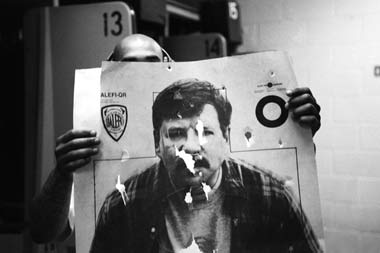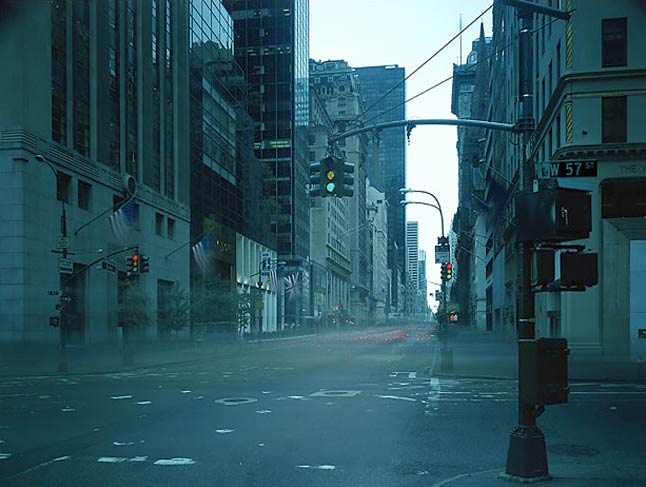U.S.
They take apart their nightmares and they leave them by the door
Over the last several months, 22,741 New Yorkers contacted the city’s Department of Sanitation and arranged for the pickup of refrigerators, air-conditioners and freezers. In more than 11,000 instances, the machines vanished before sanitation workers arrived in their white trucks to pick them up.
Who, then, is stealing the household appliances of New York City?
Scavengers, to be sure, abound in New York, especially during tough economic times. But the sheer magnitude of the thefts — 11,528 appliances, to be precise — over a relatively brief period suggests to some in city government and the recycling industry that a more organized enterprise may be at work as well.
‘The procedure which consists of endlessly finding some novelty in order to escape the preceding results is offered up to agitation, but nothing is more stupid.’ –George Bataille

The usual black bottom strip on those signs has been replaced by a colorful set of horizontal lines, evoking the aesthetic of the subway map. The transportation authority’s circular blue logo now sits atop the poster, astride a helpful “.info” to direct passengers to the authority’s Web site. The MTA worked with its longtime agency, Korey Kay Partners, the agency that created the “SubTalk” motto in 1993.
All the tondo gang bola del ruffo

{ It has long been true that California on its own would rank as one of the biggest economies of the world. These days, it would rank eighth, falling between Italy and Brazil on a nominal exchange-rate basis. But how do other American states compare with other countries? | The Economist }
‘Life is a business that does not cover the costs.’ –Schopenauher

It has been a year since I drove a cab, but the old garage still looks the same. (…)
Shape-up time at Dover Taxi Garage #2 still happens every afternoon, rain or shine, winter or summer, from two to six. That’s when the night-line drivers stumble into the red-brick garage on Hudson Street in Greenwich Village and wait for the day liners, old-timers with backsides contoured to the crease in the seat of a Checker cab, to bring in the taxis. The day guys are supposed to have the cabs in by four, but if the streets are hopping they cheat a little bit, maybe by two hours. That gives the night liners plenty of time to stand around in the puddles on the floor, inhale the carbon monoxide, and listen to the cab stories.
Cab stories are tales of survived disasters. They are the major source of conversation during shape-up. (…)
A year ago or so, any woman hanging out at shape-up was either waiting to report a driver for stealing her pocketbook, a Dover stiff’s girl friend, or some sort of crazy cabdriver groupie. In those days, the two or three women who were driving were banned from the night line, which is notably unfair because you can make a lot more money with a lot less traffic driving at night. Claire, a long-time Dover driver, challenged the rule and won; now fifteen women drive for Dover, most on the night line. (…)
It doesn’t take a cabdriver too long to realize that once you leave the joy of shape-up and start uptown on Hudson Street, you’re fair game. You’re at the mercy of the Fear Variables, which are (not necessarily in order): the traffic, which will be in your way; the other cabdrivers, who want to take your business; the police, who want to give you tickets; the people in your cab, lunatics who will peck you with nudges and dent you with knives; and your car, which is capable of killing you at any time. Throw in your bosses and the back inspectors and you begin to realize that a good night is not when you make a living wage. That’s a great night. A good night is when you survive to tell your stories at tomorrow’s shape-up. But all the Fear Variables are garbage compared with the Big Fear. The Big Fear is that times will get so hard that you’ll have to drive five or six nights a week instead of three.
Of the many thousands of events canceled by the snow, it might have been convenient if Friday’s scheduled rollout of the great New York share-a-taxicab-with-a-stranger experiment of 2010 were not among them.
Alas.
Communal rides in the city’s yellow cab fleet will now start Wednesday, the Taxi and Limousine Commission said.
The share-a-cab program will allow up to four passengers to ride carpool-style along three preset routes in Manhattan, at a flat fare of $3 or $4 a head. Drop-offs will be allowed along Park Avenue down to Grand Central Terminal. For now, shared rides will only be allowed between 6 and 10 a.m. on weekdays.
photo { David Stewart }
A violet in the youth of primy nature

The Soviet and Japanese threats to American supremacy proved chimerical. (…) The Chinese challenge to the United States is more serious for both economic and demographic reasons. The Soviet Union collapsed because its economic system was highly inefficient, a fatal flaw that was disguised for a long time because the USSR never attempted to compete on world markets. China, by contrast, has proved its economic prowess on the global stage. Its economy has been growing at 9 to 10 percent a year, on average, for roughly three decades. It is now the world’s leading exporter and its biggest manufacturer, and it is sitting on more than $2.5 trillion of foreign reserves. Chinese goods compete all over the world. This is no Soviet-style economic basket case.
Japan, of course, also experienced many years of rapid economic growth and is still an export powerhouse. But it was never a plausible candidate to be No. 1. The Japanese population is less than half that of the United States, which means that the average Japanese person would have to be more than twice as rich as the average American before Japan’s economy surpassed America’s. That was never going to happen. By contrast, China’s population is more than four times that of the United States. The famous projection by Goldman Sachs that China’s economy will be bigger than that of the United States by 2027 was made before the 2008 economic crash. At the current pace, China could be No. 1 well before then.
photo { Christopher Schreck }
You know, you were always one of the bright ones, since a foot made you an unmentionable, fakes!

The belief culture thrives on the false principle that all opinions are equal, even those without a shred of factual data, documentation, or reasoned methodology. It is a culture in which one in 20 Americans believe NASA faked the Apollo moon landings, and half the population believes the world was made in six days. (…)
There is a certain irony in the case of the United States, a nation founded on Enlightenment principles of rationality and now so eagerly becoming a culture of raw, unquestioning belief.
Rattle big black bones in the danger zone

{ The US authorities have discovered 20 tonnes of marijuana, worth tens of millions of dollars, in one of the most advanced illegal tunnels ever found. The passage is half a mile long and runs from inside a house in Mexico straight under the border with the United States and into a warehouse in San Diego. | BBC | video }
‘Donc défaire la ressemblance ça a toujours appartenu à l’acte de peindre.’ –Deleuze

{ I came out the door the other day to find this girl sitting on my steps smoking a joint with a friend. She apologized for smoking there and I said there was no problem until there was a problem which she seemed to like. I told her I liked her tattoos and asked if I could take her picture. She seemed flattered. While photographing her I asked how the LAPD liked her tattoos and she said “Yeah…they like to photograph them too.” | Tracy photographed by Stephen Zeigler }
we own the night

{ the adventures of imp on 6th avenue, december 7, 2010, 11pm }
And the steam heat is drippin’ off the walls

Niagara Falls’ descent into blight—in spite of its proximity to an attraction that draws at least 8 million tourists each year—is a tale that Hudson’s little newspaper has been telling for years. It encompasses just about every mistake a city could make, including the one Frankie G. cited: a 1960s mayor’s decision to bulldoze his quaint downtown and replace it with a bunch of modernist follies. There was a massive hangar-like convention center designed by Philip Johnson; Cesar Pelli’s glassy indoor arboretum, the Wintergarden, which was finally torn down because it cost a fortune to heat through the Lake Erie winter; a shiny office building known locally as the “Flashcube,” formerly the headquarters of a chemical company and now home to a trinket market. Once a hydropowered center of industry, Niagara Falls is now one of America’s most infamous victims of urban decay, hollowed out by four decades of job loss, mafia infiltration, political corruption, and failed get-fixed-quick schemes. Ginger Strand, author of Inventing Niagara: Beauty, Power, and Lies, called the place “a history in miniature of wrongheaded ideas about urban renewal.”
photo { Paul Rodriguez }
‘Our social personality is created by the thoughts of other people.’ –Proust
Women are getting as good as they’re giving. By ages 25-29, 88 percent say they’ve received oral sex from a man, and 72 percent say they’ve received it in the last year. (…)
In 1992, 16 percent of women aged 18-24 said they’d tried anal sex. Now 20 percent of women aged 18-19 say they’ve done it, and by ages 20-24, the number is 40 percent. In 1992, the highest percentage of women in any age group who admitted to anal sex was 33. In 2002, it was 35. Now it’s 46. (…)
Among women who had vaginal sex in their last encounter, the percentage who said they reached orgasm was 65. Among those who received oral sex, it was 81. But among those who had anal sex, it was 94. Anal sex outscored cunnilingus.
No way, you say. Way. Read the data.
‘All I can do is be me, whoever that is.’ –Bob Dylan
Men and women have been pairing off since the dawn of humanity. For most of its history, marriage was an economic institution that created advantageous alliances between clans and was arranged, often, without much input from the bride or groom. But by the 19th century, many in the Western world had begun to marry for love, making the relationship infinitely more complicated and divorce a lot more common.
Romantic love assumed a position of high value but even higher vulnerability.
Still, until the second half of the 20th century, these ubiquitous couplings went largely unstudied. What happened behind closed doors generally remained private, unless one had a particularly nosy set of in-laws or a manner of fighting that necessitated police intervention.
Marriages, with the power to affect everything from personal income levels to mental and physical health, remained a hazy mystery. But with the advent of the affordable video camera in the late 1960s, psychologists began recording couples’ interactions. The scientists hooked up their subjects to monitors that detected changes in blood pressure or stress hormones, and then coded even their slightest movements — an eye roll or a knuckle crack. The couples were interviewed about their marital satisfaction and were, in some cases, tracked for years.
{ Washington Post | Continue reading }
Unhappy couples in New York have long gone to extremes to throw off the shackles of matrimony—in the worst cases, framing their spouses, producing graphic testimony about affairs, or even confessing to crimes they did not commit. All this will fade into the past if, as expected, Gov. David Paterson signs a bill making New York the last state in the country to adopt unilateral no-fault divorce.
Their counterparts in other states have had it much easier. California adopted the first no-fault divorce bill in 1970; by 1985, every other state in the nation—but one—had passed similar laws. In New York, the miserably married must still charge each other with cruel and inhuman treatment, adultery or abandonment—or wait one year after a mutually agreed legal separation—in order to divorce.
Come with me, tonight’s the night

America remains the world’s richest large country. It’s generally estimated to have a per capita GDP level around $45,000, while the richest European nations manage only a $40,000 or so per capita GDP (setting aside low population, oil-rich states like Norway). Wealth underlies America’s sense of itself as a special country, and it’s also cited as evidence that America is better than other economies on a range of variables, from economic freedom to optimism to business savvy to work ethic.
But why exactly is America so rich? Karl Smith ventures an explanation:
I am going to go pretty conventional on this one and say a combination of three big factors
1. The Common Law
2. Massive Immigration
3. The Great Scientific Exodus during WWII
related { 5 Myths about the Fed }
photo { Young Kyu Yoo }
‘Taste is made of a thousand distastes.’ –Paul Valéry

The Ford Crown Victoria has long been the most widely used vehicle in New York City’s taxi fleet. But Ford is retiring the Crown Vic next year, and that means NYC needs to find a replacement.
Enter the Taxi of Tomorrow competition, a project created by city officials to find the next major taxi model.
So far, the city has narrowed the competition down to three finalists. The winner, which will be picked next year, will have an exclusive contract to provide the city with taxi cabs.
{ Fast Company | Continue reading }
In 2007, TLC’s Board of Commissioners approved a new package of taxi stickers. Smart Design, a design firm, produced and donated the new logo designs to TLC.
Taxi drivers and owners purchased the stickers from authorized printers.
The 4 stickers (per vehicle side) in the logo package were: a fare panel, the NYCTAXI sticker, the medallion number and a checker stripe decal.
The purest bliss was surely then thy dower

In 1978, the divorce rate was much higher than it is today. (…)
Americans still venerate marriage enough to want to try it. About 70% of us have been married at least once, according to the 2010 Census. (…)
41% of babies were born to unmarried moms in 2008, an eightfold increase from 50 years ago, and 25% of kids lived in a single-parent home, almost triple the number from 1960. Contrary to the stereotype, it turns out that most of the infants born to unmarried mothers are not the product of casual sexual encounters. (…)
Most of those unwed mothers said their chances of marrying the baby’s father were 50% or greater, but after five years, only 16% of them had done so and only about 20% of the couples were still cohabiting. This didn’t mean that the children didn’t live with a man, however, since about a quarter of their moms were now living with or married to a new partner.
screenshot { Michelangelo Antonioni, The Eclipse, 1962 }
We tote big guns, and everybody know somebody that know somebody that know somethin’ about it

New York City in the 1920s and ’30s was a hotbed of criminal activity. Prohibition laws banning the production, sale and distribution of alcohol had been introduced, but instead of reducing crime, they had the opposite effect. Gangsters organized themselves and seized control of the alcohol distribution racket, smuggling first cheap rum from the Caribbean, then French champagne and English gin, into the country. Speakeasies sprang up in every neighbourhood, and numbered more than 100,000 by 1925. When prohibition was abolished in 1933, the gangsters took to other activities, such as drug distribution, and crime rates continued to increase.
At the forefront of the city’s efforts to keep crime under control was a man named Carleton Simon. Simon trained as a psychiatrist, but his reach extended far beyond the therapist’s couch. He became a ‘drug czar’ six decades before the term was first used, spearheading New York’s war against drug sellers and addicts. He was a socialite and a celebrity, who made a minor contribution to early forensic science by devising new methods to identify criminals. He also tried to apply his knowledge to gain insights into the workings of the criminal brain, becoming, effectively, the first neurocriminologist.
Simon was born in New York City on February 28th, 1871, and studied in Vienna and Paris, graduating with an M.D. in 1890. Afterwards, he conducted sleep research. (…) Eventually, Simon became interested in criminology and psychopathology, and by the turn of the century had abandoned his psychiatric research to focus on these disciplines. (…)
Towards the end of the 1930s crime was estimated to cost the U.S. approximately $15 billion annually. Knowledge of brain function and dysfunction was very rudimentary by today’s standards, and criminals and psychopaths were often lobotomized or subjected to electroconvulsive therapy in order to keep them under control. Another treatment available was insulin shock therapy, which had been introduced by Manfred Sakel in 1933, and involved giving patients large repeated doses of the hormone to induce coma. It was around this time that Simon proposed a new theory, which he believed would help science to understand and control the criminal mind.
The theory drew on the concept of cerebral dominance, which had emerged some 70 years earlier, largely from Paul Broca’s investigations of stroke patients. (…) According to Simon’s theory, criminality occurs as a result of a shift in cerebral dominance, whereby the normally submissive right hemisphere gains mastery of the brain, leading to irrational behaviour.
photo { Alessandro Zuek Simonetti }
My team been puffing chiba and packing heaters since the days of shell toe Adidas

Taliban Leader in Peace Talks Was an Impostor
For months, the secret talks unfolding between Taliban and Afghan leaders to end the war appeared to be showing promise, if only because of the appearance of a certain insurgent leader at one end of the table: Mullah Akhtar Muhammad Mansour, one of the most senior commanders in the Taliban movement.
But now, it turns out, Mr. Mansour was apparently not Mr. Mansour at all. In an episode that could have been lifted from a spy novel, United States and Afghan officials now say the Afghan man was an impostor, and high-level discussions conducted with the assistance of NATO appear to have achieved little.
“It’s not him,” said a Western diplomat in Kabul intimately involved in the discussions. “And we gave him a lot of money.”
photo { Jacques-André Boiffard, 1930 }








